May Gabat
May Gabat is a river of northern Ethiopia. Rising in the mountains of Inderta (2233 metres above sea level), it flows westward to Giba River which empties finally in the Tekezé River.[2] The Gereb Segen reservoir has been built on this river in 2016, mainly for providing Mekelle with potable water.[3]
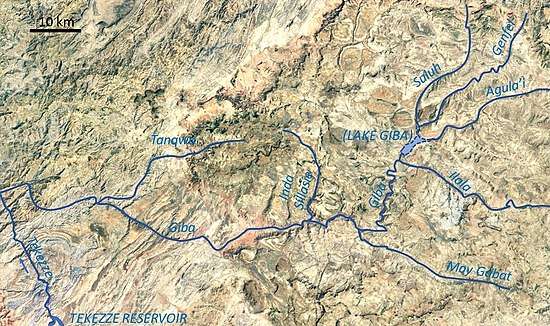
| May Gabat | |
|---|---|
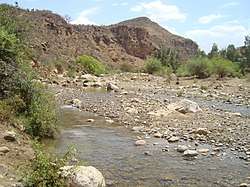 The May Gabat River near the confluence with Giba River | |
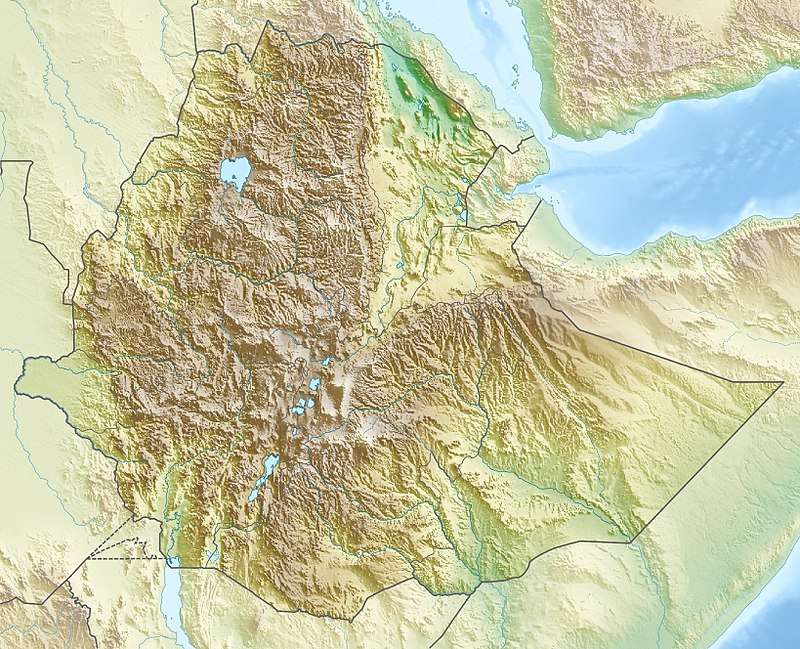 May Gabat River in Tigray Region | |
| Location | |
| Country | Ethiopia |
| Region | Tigray Region |
| Districts (woreda) | Inderta |
| Physical characteristics | |
| Source | Hiza'iti Wedi Cheber |
| • location | Mereb Miti in Inderta |
| • elevation | 2,233 m (7,326 ft) |
| Mouth | Giba River |
• location | Kayeh Guila in Debre Nazret municipality |
• coordinates | 13.476°N 39.297°E |
• elevation | 1,590 m (5,220 ft) |
| Length | 42 km (26 mi) |
| Basin size | 652 km2 (252 sq mi) |
| Width | |
| • average | 15 m (49 ft) |
| Discharge | |
| • location | Near confluence with Giba River[1] |
| • maximum | 190 m3/s (6,700 cu ft/s) |
| Basin features | |
| River system | Permanent river |
| Tributaries | |
| • right | Kalamino River |
| Waterbodies | Hiza'iti Wedi Cheber, Gereb Segen, Gereb Bi'ati, Addi Hilo |
| Waterfalls | Maryam Bahrawti |
| Bridges | Mereb Miti; road to Gijet |
| Topography | Mountains and deep gorges |
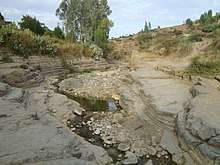
Hydrography
It is a confined river, locally meandering in its narrow alluvial plain, with a slope gradient of 15 metres per kilometre. With its tributaries, the river has cut a deep gorge.[4]
Tributaries
Main tributary is Kalamino River which drains a large part of Mekelle; it joins May Gabat downstream from the Gereb Segen reservoir.
Hydrology
Hydrological characteristics
The runoff footprint or annual total runoff volume is 58 million m³. Peak discharges up to 190 m³ per second occur in the second part of the rainy season (month of August) when there are strong rains and the soils are saturated with water in many places. The percentage of total rainfall that directly leaves the catchment as storm runoff (also called runoff coefficient) is 9%. As limestone is present in 28% of the catchment this runoff coefficient is less than that of adjacent rivers.[1]
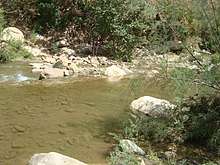
The total amount of sediment that is transported by this river amounts to 373,000 tonnes per year. Median sediment concentration in the river water is 1.8 grammes per litre, but may go up to 64 g/L. The highest sediment concentrations occur at the beginning of the rainy season, when loose soil and dust is washed away by overland flow and ends up in the river.[5] As such water contains many nutrients (locally it is called “aygi”), farmers estimate that it strengthens their cattle, which they will bring to the river.[4] All in all, average sediment yield is 752 tonnes per km² and per year. All measurements were done at a purposively installed station near the mouth of the river, in the years 2006–2007.[5] It is anticipated that the mentioned values have strongly decreased after construction of the Gereb Segen reservoir, because it intercepts water and sediment.
Flash floods
Runoff mostly occurs in the form of high runoff discharge events that occur in a very short period (called flash floods). These are related to the steep topography, often little vegetation cover and intense convective rainfall. The peaks of such flash floods have often a 50 to 100 times larger discharge than the preceding baseflow. These flash floods mostly occur during the evening or night, because the convective rain showers occur in the afternoon.[4]
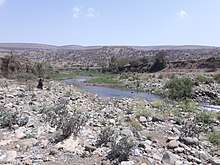
Changes over time
Evidence given by Italian aerial photographs of the catchment, taken in the 1930s show that 48% of the catchment was covered with woody vegetation (against 33% in 2014). This vegetation could better slow down runoff in earlier times. On the other hand, five reservoirs intercepted already the floods in the headwaters and the runoff coefficient was smaller in 2014 (12% in 1935 against 9% in 2014).[6] Up to the 1980s, there was strong pressure on the environment, and much vegetation disappeared.[7] This river had its greatest discharges and width in that period. The magnitude of floods in this river has also been decreased in recent years due to interventions in the catchment. On steep slopes, exclosures have been established; the dense vegetation largely contributes to enhanced infiltration, less flooding and better baseflow.[8] Physical conservation structures such as stone bunds[9][10] and check dams also intercept runoff.[11][12]
Irrigated agriculture
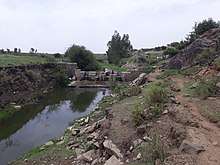
Besides springs and reservoirs, irrigation is strongly dependent on the river's baseflow. Such irrigated agriculture is important in meeting the demands for food security and poverty reduction.[4] Irrigated lands are established in the narrow alluvial plains along the river in many places; the farmers use motor pumps to pump baseflow water generated by seepage from Hiza'iti Wedi Cheber, Gereb Segen and Gereb Bi'ati reservoirs.
Transhumance towards the river gorge
The valley bottoms in the lower gorge of this river have been identified as a transhumance destination zone. Transhumance takes place in the summer rainy season, when the lands near the villages are occupied by crops. Young shepherds will take the village cattle down to the gorge and overnight in small caves. The gorges are particularly attractive as a transhumance destination zone, because there is water and good growth of semi-natural vegetation.[13]
Boulders and pebbles in the river bed
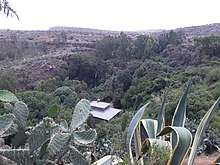
Boulders and pebbles encountered in the river bed can originate from any location higher up in the catchment. In the uppermost stretches of the river, only rock fragments of the upper lithological units will be present in the river bed, whereas more downstream one may find a more comprehensive mix of all lithologies crossed by the river. From upstream to downstream, the following lithological units occur in the catchment.[14]
- Amba Aradam Formation
- Antalo Limestone
- Mekelle Dolerite
- Quaternary freshwater tufa[15]
- Adigrat Sandstone
Natural boundary
During its course, this river passes through Inderta district.[2] In historical times, the Inderta Province was wider than currently, and May Gabat constituted the border between Inderta proper (capital: Mekelle) and Gabat Mellash, literally meaning "beyond (May) Gabat”, with Hintalo as its capital.[16]
Trekking
Trekking routes have been established in nearby Dogu'a Tembien.[17] The tracks are not marked on the ground but can be followed using downloaded .GPX files.[18] Trek 18, through the southwestern mountains of Dogu'a Tembien, allows panoramic views on lower May Gabat (including Gereb Segen reservoir) and the river mouth.
See also
- List of Ethiopian rivers
References
- Amanuel Zenebe, and colleagues (2013). "Spatial and temporal variability of river flows in the degraded semi-arid tropical mountains of northern Ethiopia". Zeitschrift für Geomorphologie. 57 (2): 143–169. doi:10.1127/0372-8854/2012/0080.
- Jacob, M. and colleagues (2019). Geo-trekking map of Dogu'a Tembien (1:50,000). In: Geo-trekking in Ethiopia's Tropical Mountains - The Dogu'a Tembien District. SpringerNature. ISBN 978-3-030-04954-6.
- https://link.springer.com/article/10.1007/s10064-019-01577-0#Sec8 Electrical resistivity imaging and engineering geological investigation of Gereb Segen dam, northern Ethiopia
- Amanuel Zenebe, and colleagues (2019). The Giba, Tanqwa and Tsaliet rivers in the headwaters of the Tekezze basin. In: Geo-trekking in Ethiopia's Tropical Mountains - The Dogu'a Tembien District. SpringerNature. doi:10.1007/978-3-030-04955-3_14. ISBN 978-3-030-04954-6.
- Vanmaercke, M. and colleagues (2010). "Sediment dynamics and the role of flash floods in sediment export from medium-sized catchments: a case study from the semi-arid tropical highlands in northern Ethiopia". Journal of Soils and Sediments. 10 (4): 611–627. doi:10.1007/s11368-010-0203-9.
- Etefa Guyassa, 2017. PhD thesis. Hydrological response to land cover and management (1935-2014) in a semi-arid mountainous catchment of northern Ethiopia
- Frankl, A., Nyssen, J., De Dapper, M., Mitiku Haile, Billi, P., Munro, R.N., Deckers, J. Poesen, J. 2011. Linking long-term gully and river channel dynamics to environmental change using repeat photography (North Ethiopia). Geomorphology, 129 (3-4): 238-251.
- Descheemaeker, K. and colleagues (2006). "Runoff on slopes with restoring vegetation: A case study from the Tigray highlands, Ethiopia". Journal of Hydrology. 331 (1–2): 219–241. doi:10.1016/j.still.2006.07.011.
- Nyssen, Jan; Poesen, Jean; Gebremichael, Desta; Vancampenhout, Karen; d'Aes, Margo; Yihdego, Gebremedhin; Govers, Gerard; Leirs, Herwig; Moeyersons, Jan; Naudts, Jozef; Haregeweyn, Nigussie; Haile, Mitiku; Deckers, Jozef (2007). "Interdisciplinary on-site evaluation of stone bunds to control soil erosion on cropland in Northern Ethiopia". Soil and Tillage Research. 94 (1): 151–163. doi:10.1016/j.still.2006.07.011. hdl:1854/LU-378900.
- Gebeyehu Taye and colleagues (2015). "Evolution of the effectiveness of stone bunds and trenches in reducing runoff and soil loss in the semi-arid Ethiopian highlands". Zeitschrift für Geomorphologie. 59 (4): 477–493. doi:10.1127/zfg/2015/0166.
- Nyssen, J.; Veyret-Picot, M.; Poesen, J.; Moeyersons, J.; Haile, Mitiku; Deckers, J.; Govers, G. (2004). "The effectiveness of loose rock check dams for gully control in Tigray, Northern Ethiopia". Soil Use and Management. 20: 55–64. doi:10.1111/j.1475-2743.2004.tb00337.x.
- Etefa Guyassa and colleagues (2017). "Effects of check dams on runoff characteristics along gully reaches, the case of Northern Ethiopia". Journal of Hydrology. 545 (1): 299–309. doi:10.1016/j.jhydrol.2016.12.019.
- Nyssen, Jan; Descheemaeker, Katrien; Zenebe, Amanuel; Poesen, Jean; Deckers, Jozef; Haile, Mitiku (2009). "Transhumance in the Tigray highlands (Ethiopia)". Mountain Research and Development. 29 (3): 255–264. doi:10.1659/mrd.00033.
- Sembroni, A.; Molin, P.; Dramis, F. (2019). Regional geology of the Dogu'a Tembien massif. In: Geo-trekking in Ethiopia's Tropical Mountains — The Dogu'a Tembien District. SpringerNature. ISBN 978-3-030-04954-6.
- Moeyersons, J. and colleagues (2006). "Age and backfill/overfill stratigraphy of two tufa dams, Tigray Highlands, Ethiopia: Evidence for Late Pleistocene and Holocene wet conditions". Palaeogeography, Palaeoclimatology, Palaeoecology. 230 (1–2): 162–178. Bibcode:2006PPP...230..165M. doi:10.1016/j.palaeo.2005.07.013.
- Sarah Vaughan, "Ethnicity and Power in Ethiopia", PhD dissertation, p. 123, 2003
- Description of trekking routes in Dogu'a Tembien. In: Geo-trekking in Ethiopia's Tropical Mountains - The Dogu'a Tembien District. SpringerNature. 2019. ISBN 978-3-030-04954-6.
- https://www.openstreetmap.org/traces/tag/nyssen-jacob-frankl